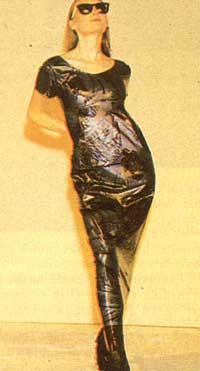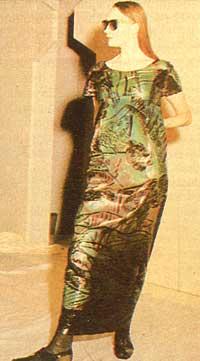Color of clothes according to current heat
1991/11/01 Aizpurua Sarasola, Joxerra Iturria: Elhuyar aldizkaria

Chemists, through research into materials that change color depending on heat, have opened up new possibilities for making. The first clothing was presented last May at the Hotel Savoy in London.
These amazing clothes explained very well the shapes of the body and were endowed with the colors of the rainbow. These garments absorb heat from the body and change color. They are black by not absorbing body heat when stored in the closet.
The chemists of the company Merck, located in the British city of Dorset, found materials that changed color. One of the materials was red around 28°C, blue around 33°C and other colours in intermediate temperatures.
Merck chemists have been researching liquid crystal materials for 10 years. It is known that liquid crystals are used in clocks, televisions and computer monitors. Temperature-sensitive liquid crystals are the result of a joint investigation by Merck, the University of Hull and the Defense Research Agency.
According to Ian Sage, development director at Merck, the most important applications of thermochromic materials are in engineering and medicine.
We must thank Moira Donnelly, organizer of fashion exhibitions for the idea of making thermochromic garments.

Martin Pellatt, director of the new materials area at Merck, explained the technology of these special garments. Temperature-sensitive substances are found in the ink placed in a black fabric. All colors that do not reflect the thermochromic ink layer are absorbed by the black fabric. The thickness of the ink layer varies between 35 and 40 microns and is formed by capsules suspended in the aqueous resin. Each capsule contains liquid crystals. The original material of the capsule is cellulose gelatin. Gelatin is insoluble in water and protects its content from solvents and plasticizers that can eliminate the thermochromic properties of the material.
Liquid crystal consists of bar-like molecules, located as steps of the microscopic spiral staircase. In this configuration the bars absorb the light rays of certain wavelengths and others reflect them. These reflected rays color the ink.
The change in thermochromic materials makes the spiral staircase more flexible. • Changes in flexibility and shrinkage, with different colors reflected in the extent and contraction.
Mr. Sage indicates that both Merck and its partners have made a lot of progress in thermochromic materials. Materials that change color between -20°C and 100°C have been found. In this wide area you can achieve a color change in a range less than 1°C. This is very important for medical applications, for example.
However, Merck's intention is to reach those who are fashionable and for this he has launched thermochromic inks with the trademark Lichitherm.

Gai honi buruzko eduki gehiago
Elhuyarrek garatutako teknologia





